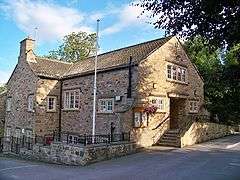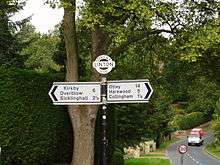Linton, West Yorkshire
Linton is a village 1.5 miles (2.4 km) south-west of Wetherby in West Yorkshire, England, in the parish of Collingham and the City of Leeds metropolitan borough. At the 2011 Census the village fell within the Harewood ward of the City of Leeds Council. It lies between Wetherby and Sicklinghall, on the north bank of the River Wharfe, opposite Collingham on the south bank.[1]
| Linton | |
|---|---|
 Linton village hall | |
 Linton  Linton Location within West Yorkshire | |
| OS grid reference | SE389468 |
| Civil parish |
|
| Metropolitan borough | |
| Metropolitan county | |
| Region | |
| Country | England |
| Sovereign state | United Kingdom |
| Post town | WETHERBY |
| Postcode district | LS22 |
| Dialling code | 01937 |
| Police | West Yorkshire |
| Fire | West Yorkshire |
| Ambulance | Yorkshire |
| UK Parliament |
|
History
Little is known of the early history of the village, but archaeologists have dated more than 8000 local flints to between 10,000 and 2000 BC, and crop marks around the village point to ditched enclosures and field systems in the Iron Age and Roman period (800 BC – AD 410). Roman artifacts have been found and in 1936 a Roman burial site was identified to the north of the village. The village is mentioned in the Domesday Book, where it has a higher value than Wetherby. The Anglo-Saxon place name means "flax farm". There was a now-vanished medieval chapel in the village, possibly founded by the Percy family, once the landowners.[2]
A Topographical Dictionary of England (ed. Samuel Lewis 1848) calls it "a township, in the parish of Spofforth, Upper division of the wapentake of Claro, W. riding of York, 1¾ mile (W. by S.) from Wetherby; containing 169 inhabitants. The township comprises by computation 1030 acres. The village is situated on the north side of the vale of the Wharfe. A rent-charge of £257. 10. has been awarded as a commutation for the tithes. There is a place of worship for Wesleyans."[3] A correspondent writing in the Leeds Mercury on 8 September 1874 notes, "On the opposite side of the Wharfe [from Collingham], perched on the hillside, is the picturesque village of Linton, the most conspicuous object being a neat Wesleyan chapel."[4] According to Kelly's Directory of 1893, Linton had four farms, a school (founded about 1859, later a church and now a dwelling house), a manor house (c. 1650 but much altered), and a public house (The Windmill Inn). The population of Linton in the 1920s was only 130.
The golf course on Linton Ings opened in 1910. The architect William Alban Jones was responsible for several houses built in the Arts and Crafts style round the old village centre in the 1920s, and also for the Memorial Hall (1947).[5]
The Grade II listed Linton Bridge was built over the River Wharfe in the early to mid-19th century.[6] It was closed in December 2015 after being damaged by flood water in the aftermath of Storm Eva, but reopened in September 2017.
Facilities

Main Street has a public house, the Windmill Inn, which includes a restaurant.[7] There is no shop or school. Wetherby Golf Club is situated in Linton. The historic Wood Hall Hotel and Spa (Hand Picked Hotels) is situated on the outskirts of the village; it has function rooms and health-club facilities.[8] The Memorial Hall has a car park and tennis courts.
Worship
The village no longer has a place of worship. It is part of the Anglican ecclesiastical parish of Wetherby with Linton, served by St James' Church in Wetherby.[9] A community of Carmelite nuns occupy a modern house near Wood Hall.[10]
Notable people
In birth order
- Owen Lattimore (1900–1989), American scholar of Mongolia and China, lived in the village in the 1960s while he was the first Professor of Chinese at the University of Leeds.
- Geoffrey Appleyard (1916–1943), an army officer of commandos much decorated in World War II, was brought up in Linton.[11]
- Ian Appleyard (1923–1998), brother of Geoffrey, was a rally driver and ornithologist.[12]
References
- Until 1974 Linton was in the West Riding of Yorkshire, and should be distinguished from Linton near Grassington, 25 miles (40 km) west, also in Wharfedale and formerly in the West Riding, but now in North Yorkshire.
- Linton Conservation Area Appraisal and Management Plan, Leeds City Council, 22 February 2010. Retrieved 23 September 2012.
- British History site. 23 September 2012.
- Parlington Hall site: Retrieved 27 September 2012.
- Parish of Collingham with Linton. Design Statement May 2010. Retrieved 22 September 2012.
- Historic England. "Details from listed building database (1225848)". National Heritage List for England. Retrieved 14 January 2016.
- Yorkshire Escapes. Retrieved 22 September 2012. Archived 10 February 2013 at Archive.today
- Yorkshire Life. Retrieved 22 September 2012.
- Church website. Retrieved 22 September 2012.
- UK Carmelite website. Retrieved 22 September 2012.
- Gordon Brown (2008), Wartime Courage: Stories of Extraordinary Courage by Ordinary People in World War Two. London: Bloomsbury Publishing. ISBN 978-0-7475-9607-3.
- "Ian Appleyard". Sports Reference. Archived from the original on 13 August 2011. Retrieved 4 March 2012.
External links
| Wikimedia Commons has media related to Linton, West Yorkshire. |
- The ancient parish of Spofforth: historical and genealogical information at GENUKI (Linton was in this parish).
- Linton Village Society, a preservation group, has a website: Retrieved 22 September 2012.
- The Design Statement contains several photographs: Retrieved 22 September 2012.